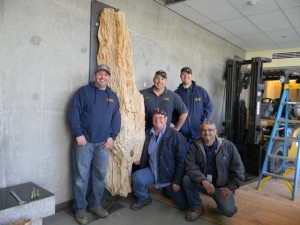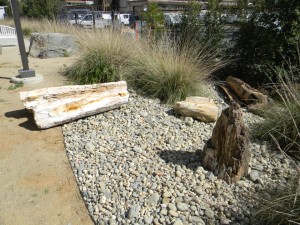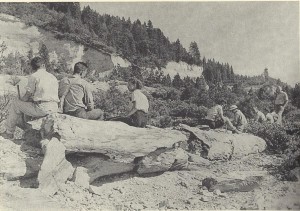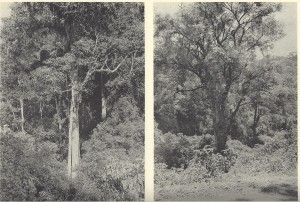This Video shows the last stage of installation of the log specimen in the west foyer of the UC Davis Geoscience Bldg. The ceiling tiles had to be removed to accommodate the height needed to lift it into place. The work crew remarked “man, this sucker is heavy!” No joke… its rock!
Here’s the photo-op at the completion of a job well done. Notice the smiles? The crew was especially happy that they didn’t drop it! Thanks to Rob Zierenberg at UC Davis for sharing the photo and video.
This large log specimen and a few others in the adjacent UC Davis Geology rock garden outside the building are a collection of petrified wood fragments extracted from the basal part of the upper, or bench, gravels of the Early Tertiary auriferous gravels in a former hydraulic mining pit called Sailor Flat located on the south flank of Quaker Hill Ridge near Nevada City.
“Extracted” is the operative word because these pieces and others that occurred with them were unearthed in the course of excavation work for residential construction on former mining property. The equipment operator would hear a loud “THUNK” and utter some expletive at having to stop work and take time to move another awkward piece of log to beyond the work area before resuming. At the end of the work there was a pile of them!
In the mining days these logs were abundant; however, now its rare to find much more than small fragments of petrified wood in the abandoned mining pits.
Over the decades the larger pieces and logs were scavenged for building materials. In many of the small towns throughout the hydraulic mining region of the Sierra foothills the petrified wood was a favorite to make wall facings and fireplace surrounds.
The hydraulic miners would use the abundance of the petrified logs that they unearthed in the course of hydraulicking to their advantage. The logs were not only durable, but also angular and tabular. So they were perfect for building water pipe and ditch abutments in the pits as these were the only such objects that would stack and not roll away!—all the other rock being round quartz boulders. So during the active hydraulic mining days, one would see these logs stacked up on abutments for “pipe viaducts” over the water/sediment ditches as the hydraulic monitors and the network of riveted iron pipe was moved throughout the mining pits.
Geologic Background The age of the log-bearing sandstone unit at this stratigraphic position is approximately late Middle Eocene. The log-bearing strata were fluvial sedimentary deposits laid down on stream cut terraces (hence, “bench” gravels in the hydraulic miners’ nomenclature). The paleochannel at this stratigraphic level was considerably wider than at the time of the deposition of the underlying “channel” or lower gravel deposits(Early to Middle Eocene). At this later time, the floodplain reached several kilometers wide at some locations.
The lithology of the sedimentary section at this stratigraphic level is less conglomeratic compared to the channel gravel units below. Clay lenses containing fossil leaves are closely associated with the log-bearing sandy layers. These clay units were probably filled abandoned meander channels. This photo shows the close proximity of the log horizon to one of the principle fossil leaf horizon locations below Chalk Bluff (background).
The sediments enveloping the logs are moderately-sorted, medium- to coarse-grained (often pebbly) unconsolidated sandstones. This sandy unit is interpreted to represent a sedimentary facies of migrating braid bar deposits on the wide flood plain. The water depth of the river would have been variable depending on the seasonal rain regimen.
A few of these wood specimens show distinct signs of rounding caused by abrasion with the quartoze clastic bedload. One can envision a fluvial setting of a wide flood plain with anastomosing or braided channels. A considerable amount of woody debris was being transported downstream as soft, water-logged driftwood either floating simi-submerged or lumbering along the sandy channel bottom. Subsiding stream flow accompanied by shallowing water depth would have beached the semi-buoyant logs and driftwood. Subsequent covering by the migrating braid bars would have enveloped the logs with the much finer grained sand…the ultimate in bi-modal grain size.
The stratigraphic position of this sandstone unit with the horizons of wood and fossil leaves occurs in the transition zone from the lower gravels (ie., Ione Formation)—in which kaolinite is the dominant matrix clay—to the upper gravels (aka Chalk Bluff unit) that gradually becomes dominated by smectite matrix clay slightly higher in the section. This striking change in the matrix clay mineralogy between the lower gravels and the upper gravels is interpreted to be a mineralogical record of the dramatic change in the global climate which began in the late Middle Eocene and culminated in the Early Oligocene. See the GSA presentation for more information on this clay mineral transition. The analysis of the associated fossil leaf assemblage led MacGinitie to equate the Sierran paleoenvironment at the time of the leaf and accompanying log deposition to the climate and ecosystem of the deciduous forests of Southern Mexico and Central America. See MacGinitie for more information of the Chalk Bluff fossil leaf assemblage and the interpreted climate at this time period. Plus, Mac has more illustrations of the various leaves in the accompanying plates.
The matrix clay in these sandstone units is actually “pseudomatrix” ie., squashed sand-sized clay clasts that were deformed in the sandy matrix. More information about this occurrence of clay in these units is discussed here, here and here.




